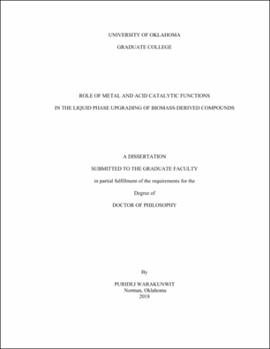| dc.description.abstract | With higher demanding of fossil fuels and the growing problems of the greenhouse effect and global warming, biofuels have drawn much attention in the research study to understand the chemistry and seek the solution to the challenges in the both in processing and economic. In this study, ethanolysis of lignin for the conversion to monomers were investigated. With the rich ether bond linkages in lignin and in order to understand more of a fundamental chemistry, 4-O-5 ether bond model compound was also studied over Ru/SiO2 and PdOTS/HY.
In the first part, ethanolysis of stillage lignin from bioethanol plant was studied in a high-pressure reactor. Ethanol shows to be an excellent solvent and source of hydrogen donor to depolymerize lignin. Performing the depolymerization at 280C in 1400 psi of H2, lignin disappearance was accounted for 60%. When the reaction was conducted with the addition of Ru/SiO2, up to 95% of solid lignin was solubilized. However, in any conditions, the maximum monomers yield was 8%. A thorough study has shown that at 280C, ethanol converts to acetaldehyde, which condensates to longer chain molecules that could potentially be blocking the active site. The catalysts also contained up to 7% of coke, which could be preferentially from trapping of larger trimers and oligomers during lignin depolymerization.
The second part of the study employed the methodology from the lignin depolymerization to biomass deconstruction. Ethanol solubilizd up to 58% of the solid Red Oak. However, less than 1% of monomers yield were detected. Upon thermal pyrolysis of the oak residue from the ethanolysis step, it suggests that most of hemicellulose and cellulose remained intact in the biomass after severe ethanolysis, which is shown in a large number of sugars and furan derivatives detected. The ethanolysis has proved to be an excellent method to isolate lignin from biomass.
The third part of this research looks into understanding the chemistry to break 4-O-5 ether linkage by studying diphenyl ether over Ru/SiO2 and PdOTS/HY. In the hydrogenation of Ru/SiO2, a surprising result suggest a carbon-carbon bond formation from the catalyst that was synthesized from the ruthenium(III) chloride precursor. The acidity that catalyzed this reaction is the Lewis acid sites on the ruthenium ions in the form of RuCl3. This ion salt came from an incomplete calcination of the precursor at 500C. From these results, PdOTS/HY catalyst was developed to maximize the carbon-carbon molecules. Upon the investigation, it shows that the carbon-carbon bond formation is maximized by a well-balanced metal and acidity. The most favorable pathway to the carbon-carbon molecule is through a partial hydrogenation of diphenyl ether followed C-O bond cleavage then alkylation of phenol and cyclohexene. | en_US |
